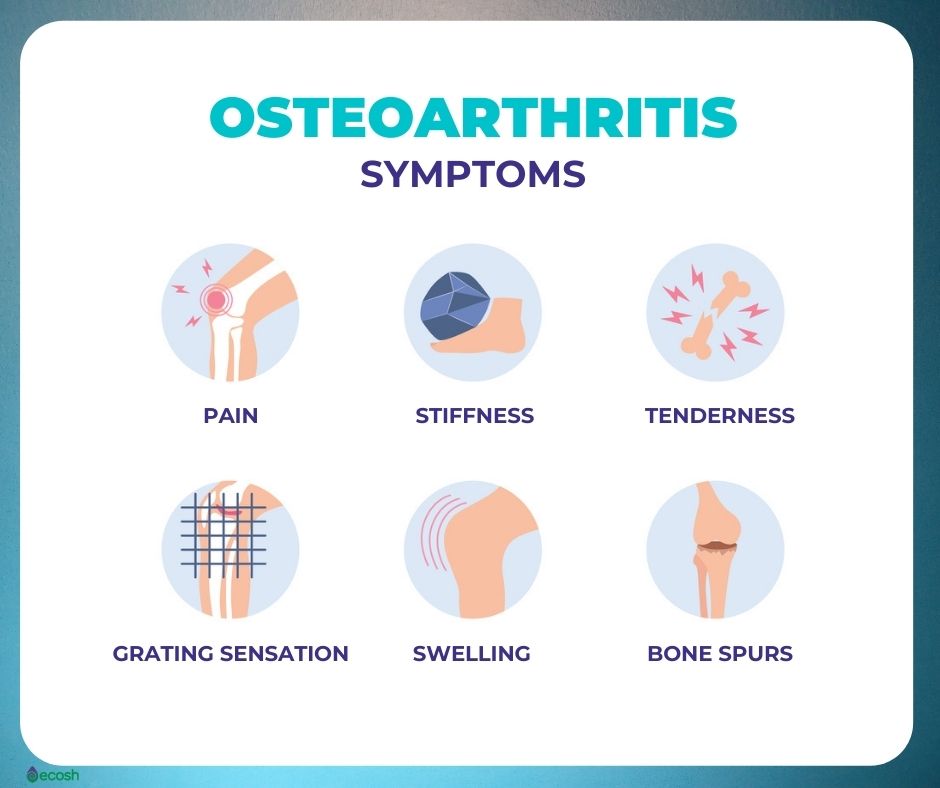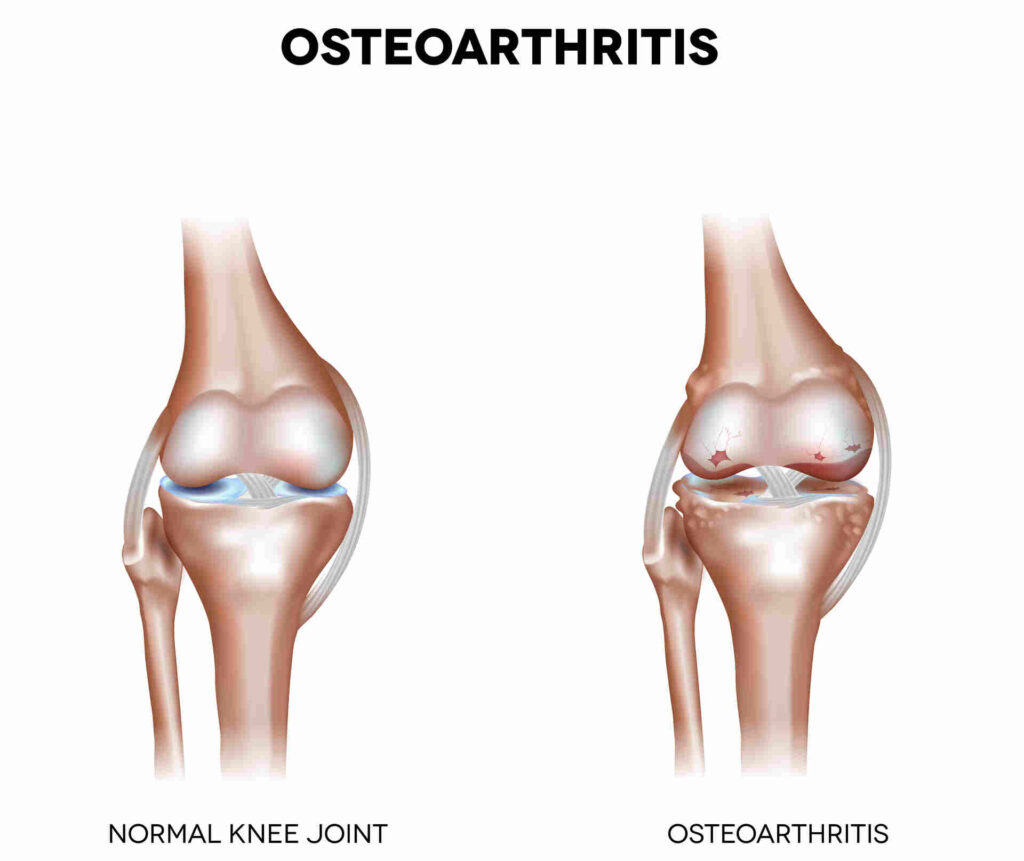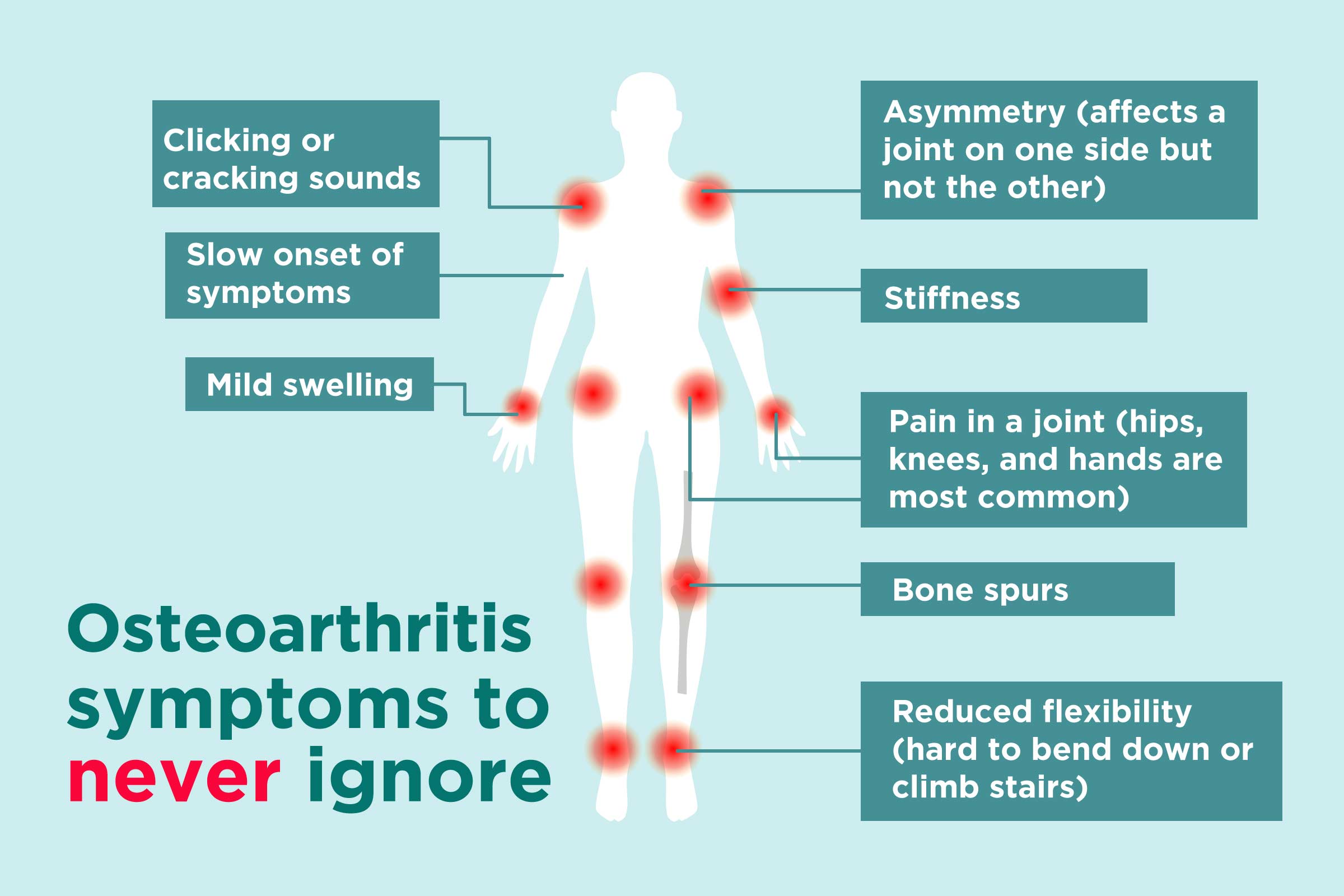Osteoarthritis symptoms-various-aspects-
Pain, stiffness, and restricted range of motion in afflicted joints are signs of osteoarthritis, a degenerative joint illness. The location and severity of these symptoms might differ; the joints most frequently affected are the hands, knees, hips, and spine.


Overview of Osteoarthritis
The tissues in the joint deteriorate over time as a result of osteoarthritis, a degenerative joint illness. It is the most prevalent kind of arthritis, especially in older individuals.
Joint discomfort is common among those who have osteoarthritis, and there is stiffness for a brief period of time after rest or inactivity. The following joints are among the most often impacted:
Hands (base and ends of thumbs and ends of fingers).
- Knees.
- hips.
- The neck.
- Lower back.
Each individual experience with osteoarthritis varies. Osteoarthritis can be rather mild for some people and have no impact on their daily lives. For others, it results in considerable suffering and impairment. While joint injury often worsens gradually over years, some individuals may experience a quick deterioration.


If any patient of ENT requires any surgery, opd consultation or online consultation in clinic of ENT specialist Doctor Dr Sagar Rajkuwar ,he may contact him at the following address-
Prabha ENT clinic, plot no 345,Saigram colony, opposite Indoline furniture Ambad link road, Ambad ,1 km from Pathardi phata Nashik ,422010, Maharashtra, India-Dr Sagar Rajkuwar (MS-ENT), Cell no- 7387590194 , 9892596635
Issued in public interest by –
What occurs during osteoarthritis?
The precise mechanism by which the joint’s tissues disintegrate is unknown to scientists. But as osteoarthritis starts to manifest, it can harm every component of the joint, such as:
The tissue that covers the ends of two bones where they join together to create a joint is called cartilage.
- Tendons and ligaments.
- The joint lining, known as the synovium.
- Bone.
- The knee’s meniscus.
Pain, swelling, and restricted joint mobility result from the progressive deterioration of the joint’s soft tissues. If you experience joint pain, you may be less physically active, which can cause muscle weakness and increase the strain on the joint. The joint may eventually change shape. Additionally, osteophytes, or bone spurs, are tiny bone growths that can develop at the joint’s margins. It is possible for the form of the bone to alter as well. Fragments of bone or cartilage may also break off and drift around in the joint space. This makes the problem worse. The cause of pain in patients with osteoarthritis is still being investigated by scientists.
Who is at risk for developing osteoarthritis?
Osteoarthritis can affect anyone, but it becomes more prevalent with age. Osteoarthritis is more prevalent among women than men, especially after the age of fifty. It often occurs in women after menopause.
Osteoarthritis can also occur in younger individuals, typically as a result of:
- Joint injury.
- The joint has an unusual structure.
- an inherited flaw in the joint cartilage.
Osteoarthritis symptoms
The symptoms of osteoarthritis often manifest gradually and typically start with just one or a few joints. Among the typical symptoms of osteoarthritis are the following:
Pain: This is frequently the most apparent symptom, which usually gets worse with exertion and better with rest.
Stiffness: Joint stiffness might be most apparent during times of inactivity, such as in the morning or after prolonged sitting.
Swelling: Particularly after usage, the injured joint may experience swelling.
Limited range of motion: Joints may become more rigid and harder to move.
Tenderness: The afflicted joint can be tender to the touch.
Grating sensation: When the joint is moved, there may be a grating or clicking feeling.
Bone spurs: Occasionally, bony growths (bone spurs) may form around the joint.
The joint may feel unstable or “give way” due to a loss of joint stability.
Muscle weakness: The afflicted joint may experience muscle loss and weakness.
Joint deformity: The joint may become obviously deformed in severe osteoarthritis.


The symptoms of osteoarthritis might vary from joint to joint. Consider the following illustration:
- Hands. The joints of the fingers might experience changes in shape and bony growth over time.
- Knees. It could sound like grinding or scraping as you walk or move. The knee may buckle over time due to ligament and muscle weakness.
- The hips. The discomfort and stiffness may occur in the hip joint, groin, inner thigh, or buttocks. The discomfort of arthritis in the hip can occasionally radiate (spread) to the knees. You might not
- be able to move your hip as far over time as you could in the past.
- Spine. The neck and lower back may experience stiffness and pain. Spinal stenosis, which can cause additional symptoms, can result from changes in the spine.
As your symptoms progress, you may find it harder to engage in activities like climbing, using the toilet, or getting out of a chair, gripping a pan, or walking across a parking lot.
Osteoarthritis symptoms such as discomfort can make you feel melancholy, exhausted, and have difficulties falling asleep.
Cause of Osteoarthritis
The cartilage and other tissues inside the joint might deteriorate or undergo structural alterations, leading to osteoarthritis. The joints do not break down as a result of ordinary wear and tear. The
breakdown, which normally occurs slowly over time, can be brought about by changes in the tissue.


Some things that might increase your chance of getting the illness are:
- Getting older.
- having an excessive body mass index (BMI).
- A history of joint injury or surgery.
- Excessive use resulting from repeated joint motions.
- Joints that are not properly aligned.
- Osteoarthritis runs in the family.
Issued in public interest by –







